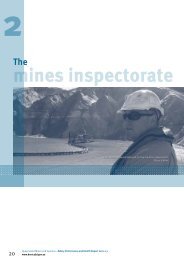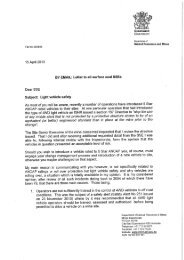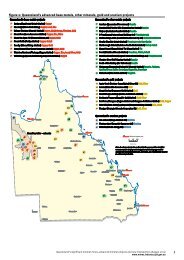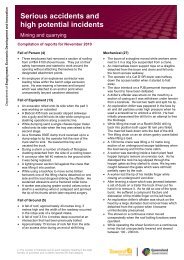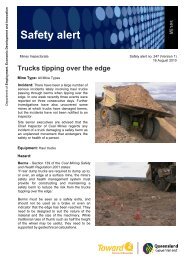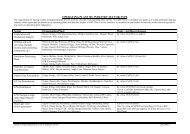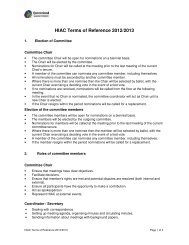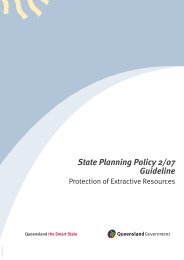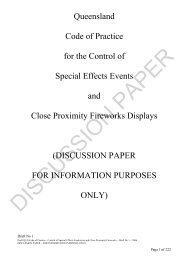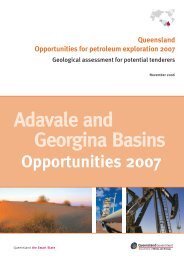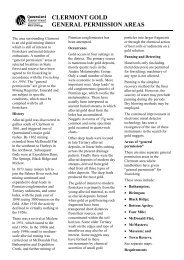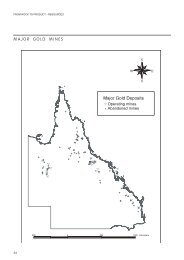Code of Practice for coal seam gas well head emissions detection ...
Code of Practice for coal seam gas well head emissions detection ...
Code of Practice for coal seam gas well head emissions detection ...
Create successful ePaper yourself
Turn your PDF publications into a flip-book with our unique Google optimized e-Paper software.
Standard leak classification<br />
The following standard <strong>gas</strong> leak classification definition has been adopted and requires reportable<br />
leaks to be notified to the P&G Inspectorate.<br />
“A Well Head Reportable Leak” is defined as:<br />
1. An emission due to an unplanned release from a CSG <strong>well</strong> site facility that, at a<br />
measurement distance <strong>of</strong> 150mm immediately above (and downwind) and surrounding the<br />
leak source in an open air environment above ground position; gives a sustained LFL<br />
reading greater than 10% <strong>of</strong> LFL <strong>for</strong> a 15 second duration.<br />
2. The following incidents/circumstances also fall under the definition and require CSG<br />
operators to notify the P&G Inspectorate:<br />
a. an unplanned hydrocarbon <strong>gas</strong> release reported by the emergency services, a public<br />
authority or member <strong>of</strong> the general public;<br />
b. an unplanned hydrocarbon <strong>gas</strong> release resulting in an incident involving fire or injury;<br />
c. an unplanned hydrocarbon <strong>gas</strong> release which receives media attention, and<br />
d. an unplanned release with the potential <strong>for</strong> significant escalation close enough to a<br />
building or other confined space and large enough that <strong>gas</strong> is likely to enter any<br />
building or confined space.<br />
An unplanned <strong>gas</strong> release that falls outside <strong>of</strong> the above parameters will be classified as an<br />
“Internally Reportable Well Head Leak” and will be subject to reporting procedures and<br />
rectification treatment in accordance with an individual company’s leak management plan and<br />
other safety management plan risk-based assessments and requirements in other safety<br />
management plans.<br />
Standard leak <strong>detection</strong> methodology<br />
A suitably trained and competent field technician will survey <strong>for</strong> <strong>gas</strong> leaks by placing the probe <strong>of</strong><br />
the <strong>gas</strong> detector immediately adjacent to but not touching (approximately 10-20mm away) all<br />
potential sources <strong>of</strong> leakage at the <strong>well</strong> facility.<br />
Should an indication <strong>of</strong> <strong>gas</strong> be found, the field technician will:<br />
1. Record the % LFL or % methane sustained <strong>for</strong> 15 seconds.<br />
2. After complying with the detector’s manufacturer’s instrument instructions <strong>for</strong> retest (eg a<br />
purge in clean atmosphere), the field technician shall retest a distance <strong>of</strong> 150mm from the<br />
leak source in all directions and determine the highest leak zone (potentially immediately<br />
above and in a downwind situation from the source).<br />
3. The highest confirmed % LFL <strong>of</strong> <strong>gas</strong> sustained <strong>for</strong> 15 seconds with the <strong>gas</strong> probe held at<br />
150mm from the potential source must be recorded.<br />
4. The source <strong>of</strong> leak must be clearly identified and recorded.<br />
A reportable <strong>well</strong> <strong>head</strong> leak is defined in the Standard leak classification section above.<br />
This standard exceeds currently accepted industry standards <strong>of</strong> <strong>detection</strong> in higher risk<br />
environments such as large scale semi enclosed <strong>gas</strong> processing and refining plants.<br />
<strong>Code</strong> <strong>of</strong> <strong>Practice</strong> <strong>for</strong> CSG <strong>well</strong> <strong>head</strong> <strong>emissions</strong>, <strong>detection</strong> and reporting - Version 2 June 2011 8



